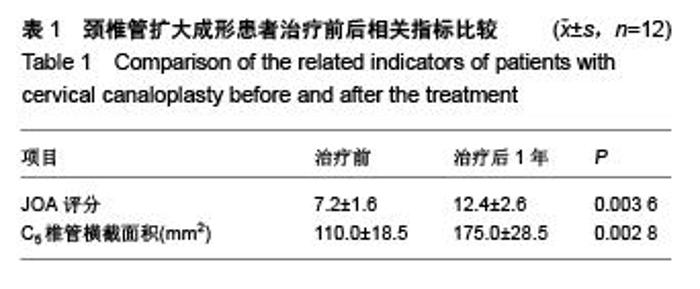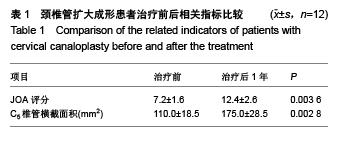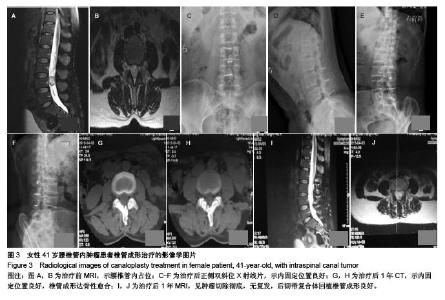Chinese Journal of Tissue Engineering Research ›› 2015, Vol. 19 ›› Issue (48): 7758-7764.doi: 10.3969/j.issn.2095-4344.2015.48.009
Previous Articles Next Articles
Application of the cannulated screws in canaloplasty
Wang Lin-feng, Ye Hong, Chen Xiao-jie, Wei Gui-cai, Jin Zhi-hui
- Nanping First Hospital Affiliated to Fujian Medical University, Nanping 353000, Fujian Province, China
-
Received:2015-10-13Online:2015-11-26Published:2015-11-26 -
About author:Wang Lin-feng, Master, Attending physician, Nanping First Hospital Affiliated to Fujian Medical University, Nanping 353000, Fujian Province, China
CLC Number:
Cite this article
Wang Lin-feng, Ye Hong, Chen Xiao-jie, Wei Gui-cai, Jin Zhi-hui . Application of the cannulated screws in canaloplasty[J]. Chinese Journal of Tissue Engineering Research, 2015, 19(48): 7758-7764.
share this article
| [1] Denis F.The three column spine and its significance in the classification of acute spinal trauma.Spine. 2002;27(3): E64-E70.[2] Hirabayashi K,Watanabe K,Wakano K,et al. Expansive open-door laminoplasty for cervical spinal stenotic myelopathy. Spine. 1983;8(7):693.[3] Yang SC,Yu SW,Tu YK,et al.Open -door laminoplasty with suture anchor fixation for cervical myelopathy in ossification of the posterior longitudinal ligament. J Spinal Disord. 2007; 20(7): 492.[4] Hirabayashi K. Operative procedure and results of expansive open-door laminoplasty. Spine. 1998;13:870.[5] Mesfin A, Park MS, Piyaskulkaew C,et al. Neck Pain following Laminoplasty. Global Spine J. 2015;5(1):17-22. [6] Vinken PJ,Bruyn GW(eds).Handbook of clinical neurology. New York:Elsevier,1975:1.[7] Tredway TL,Santiago P,Hrubes MR,et al. Minimally invasive resection of intradural-extra- medullary spinal neoplasms. Neurosurgery. 2006;58(1 suppl):52-58.[8] Wiedemayer H,Sandalcioglu IE,Aslders M,et al. Reconstruction of the laminar roof with miniplates for a posterior approach in intraspinal surgery :technical considerations and critical evaluation of follow-up results. Spine. 2004;29(16):E333-E342.[9] 章凯,吴增晖,尹庆水,等.棘突椎板回植椎管成形在胸椎后路手术中的应用[J]. 第三军医大学学报,2007,29(6):547-549.[10] Menku A,Koc RK,Oketem IS,et al.Laminoplasty with miniplates for posterior approach in thoracic and lumbar intraspinal surgery .Turk Neurosurg. 2010;20(1):27-32.[11] Hosono N,Yonenobu K, Ono K. Neck and shoulder pain after laminoplasty. Spine. 1996;21(17):1969-1973.[12] Wang MY,Green BA.Open-door cervical expansile laminoplasty. Neurosurg. 2004;54(1):119-124. [13] Edwards CC, Heller JG,Murakami H. Corpectomy versus laminoplasty for multilevel cervical myelopathy: an independent matched-cohort analysis. Spine. 2002;27: 1168-1175. [14] Wada E, Suzuki S, Kanazawa A, et al. Subtotal corpectomy versus laminoplasty for multilevel cervical spondylotic myelopathy: a long-term follow-up study over 10 years. Spine. 2001;26:1443-1448.[15] Chiba K, Toyama Y,Matsumoto M, et al. 1Segmental motor paralysisafter expansive open-door laminoplasty. Spine. 2002; 27:2108-2115.[16] 刘明,王晓,王维,等.单开门颈椎管扩大成形术的早期并发症及其防治[J].中国骨与关节损伤杂志,2005,20(7):496-497.[17] 孙宇.关于轴性症状[J].中国脊柱脊髓杂志,2008,18(4):289.[18] Yoshida M, Tamaki T, Kawakami M, et al. Does reconstruction of posterior ligamentous comp- lex with extensor musculature decrease axial symptoms after cervical laminoplasty. Spine. 2002;27:1414-1418.[19] Satomi K,Ogawa J, Ishii Y, et al. Short-term complications and long-term results of expansive open-door laminoplasty for cervical stenotic myelopathy. Spine J. 2001;1: 26-30. [20] Wang JM,Roh KJ,Kin DJ,et al.Anew method of stabilizing the elevated laminae in open-door laminoplasty:using an anchor system.J Bone Joint Surg(Br). 1998;80(6):1005.[21] Brien MF,Peterson D,Casey AT,et al.A novel technique for laminoplasty augmentation of spinal canal area using titanium miniplate stabilization:a computerized morphometric analysis. Spine. 1996;21(4):474.[22] McGirt MJ,Ambrossi GL,Parker SL,et al. Short-term progressive spinal deformity follow- ing laminoplasty versus laminectomy for resection of intradural spinal tumors:analysis of 238 patients. Neurosurgery. 2010;66(5):1005-1012.[23] Oda I,Abumi K,Cunningham BW,et al.An in vitm human cadaveric study investigating the biomechanical properties of the thoracic spine. Spine. 2002;27(3):E64-70.[24] Cusick JF,Yoganandan N, Pintar F,et al. Thoracic and lumbar laminoplasty using a transl- aminar screw: morphometric study and technique. J Neurosurg Spine. 2009;10(6):603-609.[25] 刘军曙,文建平,向孝勇,等.椎板棘突复合体截取原位回植椎管成形术在椎管内肿瘤手术中的应用[J].医学临床研究2008,25(11): 2048-2050.[26] 刘小波,林爱国,唐宏图,等.棘突椎板回植椎管成形术在椎管内肿瘤手术中的应用[J].中国临床神经外科杂志,2010,15(4): 243-244. |
| [1] | Chen Ziyang, Pu Rui, Deng Shuang, Yuan Lingyan. Regulatory effect of exosomes on exercise-mediated insulin resistance diseases [J]. Chinese Journal of Tissue Engineering Research, 2021, 25(25): 4089-4094. |
| [2] | Chen Yang, Huang Denggao, Gao Yuanhui, Wang Shunlan, Cao Hui, Zheng Linlin, He Haowei, Luo Siqin, Xiao Jingchuan, Zhang Yingai, Zhang Shufang. Low-intensity pulsed ultrasound promotes the proliferation and adhesion of human adipose-derived mesenchymal stem cells [J]. Chinese Journal of Tissue Engineering Research, 2021, 25(25): 3949-3955. |
| [3] | Yang Junhui, Luo Jinli, Yuan Xiaoping. Effects of human growth hormone on proliferation and osteogenic differentiation of human periodontal ligament stem cells [J]. Chinese Journal of Tissue Engineering Research, 2021, 25(25): 3956-3961. |
| [4] | Sun Jianwei, Yang Xinming, Zhang Ying. Effect of montelukast combined with bone marrow mesenchymal stem cell transplantation on spinal cord injury in rat models [J]. Chinese Journal of Tissue Engineering Research, 2021, 25(25): 3962-3969. |
| [5] | Gao Shan, Huang Dongjing, Hong Haiman, Jia Jingqiao, Meng Fei. Comparison on the curative effect of human placenta-derived mesenchymal stem cells and induced islet-like cells in gestational diabetes mellitus rats [J]. Chinese Journal of Tissue Engineering Research, 2021, 25(25): 3981-3987. |
| [6] | Hao Xiaona, Zhang Yingjie, Li Yuyun, Xu Tao. Bone marrow mesenchymal stem cells overexpressing prolyl oligopeptidase on the repair of liver fibrosis in rat models [J]. Chinese Journal of Tissue Engineering Research, 2021, 25(25): 3988-3993. |
| [7] | Liu Jianyou, Jia Zhongwei, Niu Jiawei, Cao Xinjie, Zhang Dong, Wei Jie. A new method for measuring the anteversion angle of the femoral neck by constructing the three-dimensional digital model of the femur [J]. Chinese Journal of Tissue Engineering Research, 2021, 25(24): 3779-3783. |
| [8] | Meng Lingjie, Qian Hui, Sheng Xiaolei, Lu Jianfeng, Huang Jianping, Qi Liangang, Liu Zongbao. Application of three-dimensional printing technology combined with bone cement in minimally invasive treatment of the collapsed Sanders III type of calcaneal fractures [J]. Chinese Journal of Tissue Engineering Research, 2021, 25(24): 3784-3789. |
| [9] | Qian Xuankun, Huang Hefei, Wu Chengcong, Liu Keting, Ou Hua, Zhang Jinpeng, Ren Jing, Wan Jianshan. Computer-assisted navigation combined with minimally invasive transforaminal lumbar interbody fusion for lumbar spondylolisthesis [J]. Chinese Journal of Tissue Engineering Research, 2021, 25(24): 3790-3795. |
| [10] | Hu Jing, Xiang Yang, Ye Chuan, Han Ziji. Three-dimensional printing assisted screw placement and freehand pedicle screw fixation in the treatment of thoracolumbar fractures: 1-year follow-up [J]. Chinese Journal of Tissue Engineering Research, 2021, 25(24): 3804-3809. |
| [11] | Shu Qihang, Liao Yijia, Xue Jingbo, Yan Yiguo, Wang Cheng. Three-dimensional finite element analysis of a new three-dimensional printed porous fusion cage for cervical vertebra [J]. Chinese Journal of Tissue Engineering Research, 2021, 25(24): 3810-3815. |
| [12] | Wang Yihan, Li Yang, Zhang Ling, Zhang Rui, Xu Ruida, Han Xiaofeng, Cheng Guangqi, Wang Weil. Application of three-dimensional visualization technology for digital orthopedics in the reduction and fixation of intertrochanteric fracture [J]. Chinese Journal of Tissue Engineering Research, 2021, 25(24): 3816-3820. |
| [13] | Sun Maji, Wang Qiuan, Zhang Xingchen, Guo Chong, Yuan Feng, Guo Kaijin. Development and biomechanical analysis of a new anterior cervical pedicle screw fixation system [J]. Chinese Journal of Tissue Engineering Research, 2021, 25(24): 3821-3825. |
| [14] | Lin Wang, Wang Yingying, Guo Weizhong, Yuan Cuihua, Xu Shenggui, Zhang Shenshen, Lin Chengshou. Adopting expanded lateral approach to enhance the mechanical stability and knee function for treating posterolateral column fracture of tibial plateau [J]. Chinese Journal of Tissue Engineering Research, 2021, 25(24): 3826-3827. |
| [15] | Zhu Yun, Chen Yu, Qiu Hao, Liu Dun, Jin Guorong, Chen Shimou, Weng Zheng. Finite element analysis for treatment of osteoporotic femoral fracture with far cortical locking screw [J]. Chinese Journal of Tissue Engineering Research, 2021, 25(24): 3832-3837. |
| Viewed | ||||||
|
Full text |
|
|||||
|
Abstract |
|
|||||



